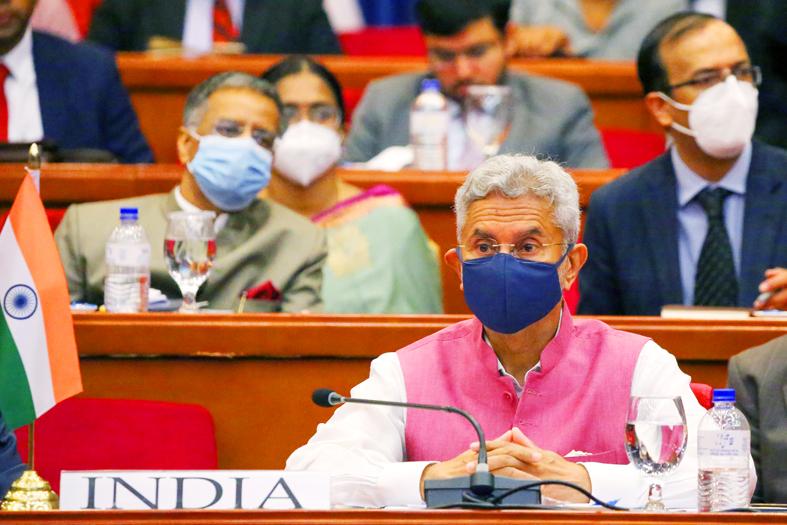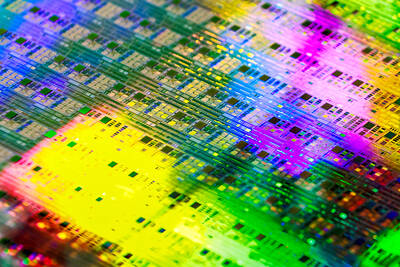India has signed an agreement to set up hybrid power projects on northern Sri Lankan islands in a deal seen as a strategic victory in its competition with China for influence in the Indian Ocean.
Indian Minister of External Affairs Subrahmanyam Jaishankar, who is in Colombo for bilateral meetings, witnessed the signing, along with Sri Lankan Minister of Foreign Affairs Gamini Peiris, the Indian embassy said late on Monday.
In December, China announced its own project to build power plants on three Sri Lankan islands was suspended due to security concerns involving a “third party.”

Photo: EPA-EFE
An Indian official said he could not confirm if the plants in the new agreement are to be built on the same islands earmarked for the Chinese project. The power source and other details on the projects were not available.
India considers Sri Lanka, just across the narrow Palk Strait off India’s southeastern coast, to be in its sphere of influence, while the island nation in the middle of a key sea route connecting the east and west, is also important to China’s ambitious “One Belt, One Road” global infrastructure initiative.
“It is kind of substantial victory for India,” said Lynn Ockersz, a senior journalist and foreign relations analyst in Sri Lanka.
“Overall, it will be in a great position to influence Sri Lanka when it comes to policy issues affecting India,” he said.
Had the Chinese power plant project been realized, it would have placed China next to India’s southern coast. India and China already have running border disputes in other regions.
Jaishankar is also taking part in the 18th Bay of Bengal Initiative for Multi-Sectoral Technical and Economic Cooperation, a meeting of Bay of Bengal nations Bangladesh, Bhutan, India, Myanmar, Nepal, Sri Lanka and Thailand for economic cooperation.
The other agreements India signed include providing a maritime rescue coordination center and building fisheries harbors in Sri Lanka.
The agreements come amid Sri Lanka’s worst economic crisis in recent memory with shortages of medicine, fuel and milk power, and daily power outages lasting for hours.
Sri Lanka has approached both India and China for help. India provided a US$1 billion credit line to buy essentials following a previous US$500 billion to buy fuel. China is considering a request for a US$2.5 billion economic assistance from Sri Lanka.
Infrastructure projects that were built on Chinese loans, but do not make money are blamed for its debt crisis. Sri Lanka’s foreign reserves are dwindling, but it has to repay US$7 billion in foreign debts this year.
China has been non-committal to a request for debt restructuring.
Beijing has invested billions of dollars in building a sea port, airport, roads and a port city on reclaimed land near Colombo harbor, which the Sri Lankan government aims to develop into a financial city.
The Sri Lankan government previously scrapped a plan to allow China outright ownership to land on the Colombo Port City and provided 62 hectares on a 99-year lease instead.

NO BREAKTHROUGH? More substantial ‘deliverables,’ such as tariff reductions, would likely be saved for a meeting between Trump and Xi later this year, a trade expert said China launched two probes targeting the US semiconductor sector on Saturday ahead of talks between the two nations in Spain this week on trade, national security and the ownership of social media platform TikTok. China’s Ministry of Commerce announced an anti-dumping investigation into certain analog integrated circuits (ICs) imported from the US. The investigation is to target some commodity interface ICs and gate driver ICs, which are commonly made by US companies such as Texas Instruments Inc and ON Semiconductor Corp. The ministry also announced an anti-discrimination probe into US measures against China’s chip sector. US measures such as export curbs and tariffs

The US on Friday penalized two Chinese firms that acquired US chipmaking equipment for China’s top chipmaker, Semiconductor Manufacturing International Corp (SMIC, 中芯國際), including them among 32 entities that were added to the US Department of Commerce’s restricted trade list, a US government posting showed. Twenty-three of the 32 are in China. GMC Semiconductor Technology (Wuxi) Co (吉姆西半導體科技) and Jicun Semiconductor Technology (Shanghai) Co (吉存半導體科技) were placed on the list, formally known as the Entity List, for acquiring equipment for SMIC Northern Integrated Circuit Manufacturing (Beijing) Corp (中芯北方積體電路) and Semiconductor Manufacturing International (Beijing) Corp (中芯北京), the US Federal Register posting said. The

India’s ban of online money-based games could drive addicts to unregulated apps and offshore platforms that pose new financial and social risks, fantasy-sports gaming experts say. Indian Prime Minister Narendra Modi’s government banned real-money online games late last month, citing financial losses and addiction, leading to a shutdown of many apps offering paid fantasy cricket, rummy and poker games. “Many will move to offshore platforms, because of the addictive nature — they will find alternate means to get that dopamine hit,” said Viren Hemrajani, a Mumbai-based fantasy cricket analyst. “It [also] leads to fraud and scams, because everything is now

MORTGAGE WORRIES: About 34% of respondents to a survey said they would approach multiple lenders to pay for a home, while 29.2% said they would ask family for help New housing projects in Taiwan’s six special municipalities, as well as Hsinchu city and county, are projected to total NT$710.65 billion (US$23.61 billion) in the upcoming fall sales season, a record 30 percent decrease from a year earlier, as tighter mortgage rules prompt developers to pull back, property listing platform 591.com (591新建案) said yesterday. The number of projects has also fallen to 312, a more than 20 percent decrease year-on-year, underscoring weakening sentiment and momentum amid lingering policy and financing headwinds. New Taipei City and Taoyuan bucked the downturn in project value, while Taipei, Hsinchu city and county, Taichung, Tainan and Kaohsiung